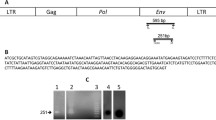Summary
Supernatant fluids from cultures of a mouse mammary tumor (MT) cell line were found to produce a specific cell detachment effect when inoculated into HeLa cells. The cell detachment factor (CDF) responsible for this effect was examined. Repeated attempts to cultivate this CDF in bacteriologic, fungal, and mycoplasma media were unsuccessful. However, using the DNA fluorochrome staining technique and specific immunofluorescent staining procedures, the CDF was identified positively as a noncultivable strain ofMycoplasma hyorhinis. It was also noted that this CDF could be labeled with [3H] uridine in MT cell cultures, concentrated, and banded at a density of 1.18 g/cm3 when centrifuged to equilibrium in a 20 to 60% sucrose gradient. Using a multiple antibiotic treatment regimen, the MT cells were “cured” of theM. hyorhinis contaminant. Re-infection of these cells with an exogenous strain ofM. hyorhinis resulted in the same cell detachment effect, and this strain when labeled with [3H]uridine also sedimented at a density of 1.18 g/cm3. The salient feature of these studies is thatM. hyorhinis sediments at the same density of mouse mammary tumor virus (MMTV) in sucrose density gradients. This was demonstrated by sucrose density gradient analyses of a purified sample of MMTV, assaying for reverse transcriptase activity, and a [3H] uridine labeled sample of theM. hyorhinis present in the MT cell cultures.
Similar content being viewed by others
References
Robinson, L. B.; Wichelhausen, R. H.; Roizman, B. Contamination of human cell cultures by pleuropneumonia-like organisms. Science 124: 1147–1148; 1956.
Barile, M. F.; Hopps, H. E.; Grabowski, M.; Riggs, D.; DelGiudice, R. A. Identification and sources of mycoplasma isolated from contaminated cell cultures. Ann. N.Y. Acad. Sci. 225: 251–262; 1973.
McGarrity, G. J.; Sarama, J.; Vanaman, V. Factors influencing microbiological assay of cell-culture mycoplasmas. In Vitro 15: 73–85; 1979.
Stanbridge, R. mycoplasmas and cell cultures. Bacteriol. Rev. 35: 206–227; 1971.
DelGiudice, R. A.; Hopps, H. E. Microbiological methods and fluorescent microscopy for the direct demonstration of mycoplasma infection of cell cultures. McGarrity, G. J.; Murphy, D. G.; Nichols, W. W. eds. Mycoplasma infection of cell cultures. New York: Plenum Publishing Corp.; 1978: 56–69.
Barile, M. F.; Schimke, R. T. A rapid chemical method for detecting PPLO contamination of tissue culture. Proc. Soc. Exp. Biol. Med. 114: 676–679; 1963.
Levine, E. M. A simplified method for the detection of mycoplasma. Methods Cell Biol. 8: 229–248; 1974.
Chen, T. R.In situ detection of mycoplasma contamination in cell cultures by fluorescent Hoechst 33258 stain. Exp. Cell Res. 104: 255–262; 1977.
DelGiudice, R. A.; Robillard, N.; Carski, T. Immunofluorescent identification of mycoplasma on agar by use of incident illumination. J. Bacteriol. 93: 1205–1209; 1967.
Harnatt, G. B.; Phillips, P. A.; Mackay-Scollay, E. M. A simple method for detecting mycoplasma infection of cell cultures. J. Clin. Pathol. 27: 70–73; 1974.
Ho, T. H.; Quinn, P. A. Rapid detection of mycoplasma contamination in tissue culture. Scan. Electron Microsc. 2: 291–299; 1977.
Todaro, G. J.; Aaronson, S. A.; Rands E. Rapid detection of mycoplasma-infected cells. Exp. Cell Res. 65: 256–257; 1971.
VanRoy, R.; Friers, W. Mycoplasma in African green monkey kidney cell cultures: Biochemical detection and effects in virus infected cells. In Vitro 13: 357–364; 1977.
Hopps, H. E.; Meyer, B. C.; Barile, M. F.; DelGiudice, R. A. Problems concerning “noncultivable” mycoplasma contamination in tissue cultures. Ann. N.Y. Acad. Sci. 225: 265–276; 1973.
DelGiudice, R. A.; Gardella, R. S.; Hopps, H. E. Cultivation of formerly noncultivable strains ofMycoplasma hyorhinis. Curr. Microbiol. 4: 75–80; 1980.
Sarkar, N. H.; Moore, D. H. Separation of B and C type virions by centrifugation in gentle density gradients. J. Virol. 13: 1143–1147; 1974.
Fine, D. L.; Arthur, L. O.; Plowman, J. K.; Hillman, E. A.; Klein, F.In vitro system for production of mouse mammary tumor virus. Appl. Microbiol. 28: 1040–1046; 1974.
Lasfargues, E. Y.; Kramarsky, B.; Sarkar, N. H.; Lasfargues, J. C.; Pillsbury, N.; Moore, D. M. An established RIII mouse mammary tumor cell line: Kinetics of mammary tumor virus production. Proc. Soc. Exp. Biol. Med. 139: 242–247; 1972.
Owens, R. B.; Hackett, A. J. Tissue culture studies of mouse mammary tumor cells and associated viruses. J. Natl. Cancer Inst. 49: 1321–1328; 1972.
Sarkar, N. H.; Pomenti, A. A.; Dion, A. S. Replication of mouse mammary tumor virus in tissue culture. I. Establishment of a mouse mammary tumor cell line, virus characterization, and quantitation of virus production. Virology 77: 12–30; 1977.
Schochetman, G.; Schlom, J. Independent polypeptide chain initiation sites for the synthesis of different classes of proteins for an RNA tumor virus: mouse mammary tumor virus. Virology 73: 431–441; 1976.
Author information
Authors and Affiliations
Rights and permissions
About this article
Cite this article
Sydiskis, R.J., Weber, P.A. & Del Giudice, R.A. Covert infection of a mouse mammary tumor cell line withMycoplasma hyorhinis: Cosedimentation with mouse mammary tumor virus in sucrose density gradients. In Vitro 17, 997–1003 (1981). https://doi.org/10.1007/BF02618425
Received:
Accepted:
Issue Date:
DOI: https://doi.org/10.1007/BF02618425




